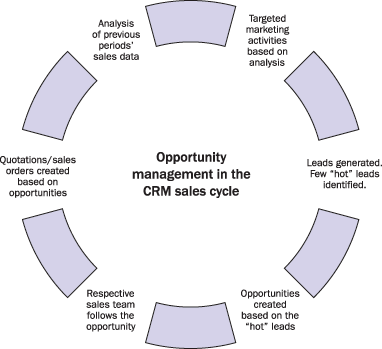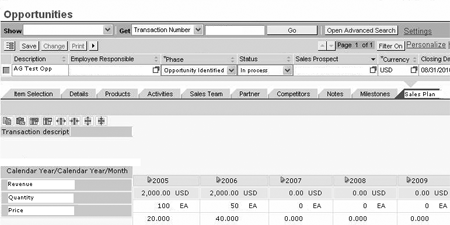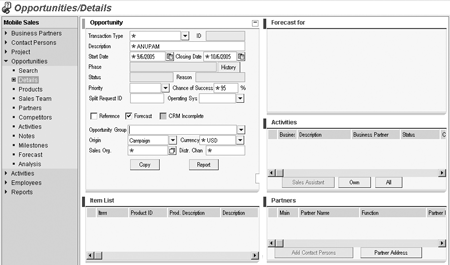You can use mySAP CRM Enterprise Sales to better manage your sales processes. Learn about its opportunity management capabilities and the typical requirements necessary to implement the module.
Key Concept
Opportunity management is a key functional area of mySAP CRM Enterprise Sales that allows you to organize your sales processes from the initial sales lead to the close of the sale. It can help you keep your sales team on track by giving it a sales process and access to important sales-related information. You can also use opportunity management to identify key decision makers. Members of your sales force who travel frequently can stay in touch with defined opportunity management through the use of Field Sales (formerly called Mobile Sales).
Poor sales management systems and the lack of a well-defined sales process lose a large proportion of sales. In an effective sales process, it is critical to identify and connect with the key decision makers at the right time. It is equally important to evaluate prospective sales deals and allocate appropriate resources (time, people, or money) according to the cost justification.
Most companies use software to capture all the information regarding a potential sale and to support opportunity management, a process that links the different steps in a sales cycle (Figure 1). This is especially true for organizations with sales cycles that run over long periods of time and include large sales teams.

Figure 1
Opportunity management in the CRM sales cycle
mySAP CRM Enterprise Sales provides a full set of opportunity management capabilities. I'll outline those capabilities, share insights into some of them, and discuss what to expect during the implementation of a typical opportunity management project. The system requirements for this solution depend on which mySAP CRM modules you have on your system. The scenario described in this article uses mySAP CRM 4.0, SAP Business Information Warehouse (BW) 3.10, and SAP NetWeaver Portal (formerly called SAP Enterprise Portal 6.0). In addition, for opportunity planning you should have Strategic Enterprise Management (SEM) 3.5 and BW 3.2.
What Is Opportunity Management?
mySAP CRM Enterprise Sales helps organizations plan and manage their sales processes, analyze their sales pipeline, and achieve an effective team-selling environment. Its opportunity management capabilities provide sales representatives with an end-to-end view of their sales opportunities by showing a complete picture of the opportunity background, timelines/milestones, and key contacts and decision makers. Enterprise Sales also captures the strength of a deal in terms of possible revenue and the probability of converting those numbers into actual sales. Enterprise Sales has many integration points with a number of other SAP modules and systems such as Business Planning and Simulation (SEM-BPS) for opportunity-related planning and BW for analytical and operational reporting.
Opportunity management provides a framework to start managing a sales project from a very early stage in a sales cycle (far in advance of closing the sale). The system generates opportunities as follow-up documents of leads generated by marketing activity. Leads link the Marketing and Sales components within mySAP CRM.
mySAP CRM allows sales representatives to capture potential sales opportunities based on their respective accounts, territories, and product areas. Sales representatives who travel can use the Field Sales component to capture opportunities along with associated forecast sales amounts. You may aggregate such plans to a higher level to help management make strategic decisions.
Key capabilities in mySAP CRM opportunity management include:
- Creation and maintenance of opportunities online (with SAPGUI or mySAP CRM People-Centric User Interface [PCUI]) as well as offline (with Field Sales)
- Forecasting of sales numbers for each opportunity
- Predelivered analytical business content that provides a set of ready-made queries to monitor opportunities. Typical reports are win/loss analysis and pipeline analysis per phase.
An opportunity document (Figure 2) can capture a range of information about a potential sales deal. At the header level, it can store information about opportunity milestones, classification (such as origin or phase), sales forecast, and business partners (such as sales team, design team, or competitors). At the item level, the opportunity document can store product information such as quantity and product-specific business partners.

Figure 2
Opportunity document displayed using SAPGUI
Integration Points
Opportunity management carries out all its tasks by relying on data from other modules in the SAP landscape. Opportunity management integrates with SAP modules and products at these seven stages:
Leads. Marketing activity, such as trade fairs, typically generates leads. They form the link between the marketing processes (campaigns) and the sales process (opportunity). Preconfigured workflow objects link leads and opportunities. Automatic opportunity creation is also possible with appropriate lead settings.
Project management. A single sales project might have multiple opportunities associated with it. Project management is particularly helpful in a large project in which different opportunities are distributed among members of a sales team based on their product expertise or other skills.
Planning. Opportunity planning is an example of closed-loop planning. This means that you analyze opportunities, apply your findings in the field, and then take the feedback from the field to reanalyze the opportunities. You could do this planning/forecasting at the opportunity level or even at the individual product level. mySAP CRM uses the SEM-BPS planning framework. You could readily use the SAP-standard planning content or develop a customized planning structure (e.g., layout, custom characteristics, key figures).
Quotations/sales orders. Quotations and sales orders are the typical follow-up documents for an opportunity. Sales people usually want to analyze the number of opportunities converted to quotations/sales orders. Technically all these entities — lead, opportunity, quotation, and sales order — have a common structure and design known as “one order object.” One order object design contains a common framework for a number of CRM transactions such as opportunities, leads, service order, and sales order. Because of a common inherent framework, the integration of these transaction documents is consistent with other entities such as organizational model, business partner services, survey tool, and pricing component.
Analysis. SAP BW is the reporting/analysis standard for mySAP CRM. It offers an exhaustive set of predelivered content to jumpstart your opportunity reporting. Some of the most relevant reports are:
- Pipeline analysis per phase (0CRM_C04_Q003) reports opportunities by phases to analyze opportunities that will close in the near future.
- Win/loss analysis (0CRM_C04_Q001) gives an idea of the conversion rate in respective areas, (i.e., if the sales teams is winning or losing sales).
- Sales volume forecast (0CRM_C04_ Q002) monitors the expected sales volume of opportunities.
SAP NetWeaver Portal. SAP NetWeaver Portal is slowly replacing SAPGUI as the preferred user interface for SAP users. SAP NetWeaver Portal provides features such as a single sign-on into multiple SAP systems and collaboration of information between different SAP modules. mySAP CRM has preconfigured content for all the sub-modules that the system could readily deploy on a portal framework. You can also post opportunity-based forecasting to the Web using the standard PCUI content (Figure 3).

Figure 3
Opportunity management in SAP NetWeaver Portal
Sales force automation (Field Sales). Sales representatives who travel can manage opportunities within Field Sales (Figure 4). This has almost as many features as the online tool. Field Sales even provides an offline planning option that you can synchronize at the end of the day with the online mySAP CRM system.

Figure 4
Sales representatives can use Field Sales to manage opportunities when they travel
Opportunity Management Implementation Expectations
An opportunity management project involving 50 users would typically take about six months to complete. Implementation of opportunity management would be spread over the phases listed in Table 1.
|
Phase
|
Duration
|
Deliverables
|
| Scoping and estimation |
2-3 weeks |
Scope document that clearly defines the features in and out of scope. Any gaps are identified at this stage. |
| Blueprinting |
6 weeks |
Blueprinting document (discusses the overall design of system), functional specifications, and test scripts for all reports and processes. Ideally, you would also develop a working prototype of the system during this phase. |
| Realization |
10 weeks |
A configured system with all the developed interfaces/ conversions and reports. |
| Implementation acceptance process (testing) |
6 weeks |
A working system ready for go-live. This involves a unit-testing phase followed by an integration-testing cycle. |
| Rollout |
1 week or more (depends on the volume of users going live) |
Involves moving over to the new system. |
| Table 1 |
Opportunity management implementation phases |
You may also want to have the following roles involved in your implementation of opportunity management.
- A project manager
- Two business process consultants to interact with the client to gather requirements and map processes
- Two functional consultants to configure the mySAP CRM system
- A CRM Middleware specialist
- One or two CRM tools consultants for CRM-related ABAP programs, conversions, enhancement Business Add-Ins (BAdIs)
- Two user interface developers per scenario. Possible scenarios include PCUI/SAP NetWeaver Portal and Field Sales
- One or two BW consultants, depending on the reporting required for standard reports or customized reports
- An SEM consultant to configure opportunity forecasting in SEM. This person could also help with the BW work.
Anupam Gupta
Anupam Gupta works as a practice manager at The Principal Consulting (TPC), managing its enterprise performance management (EPM) practice. He has more than 10 years of development and global consulting experience with SAP solutions in the areas of financial planning, reporting, and consolidation. He has significant experience advising clients on IT strategy and technology road maps. He is responsible for the development of EPM competencies, knowledge management assets, and TPC-developed solutions spanning a range of SAP products such as SAP NetWeaver BW, SAP BusinessObjects, SAP Business Planning and Consolidation, and SAP Strategic Enterprise Management.
You may contact the author at anupam.gupta@tpcus.com.
If you have comments about this article or publication, or would like to submit an article idea, please contact the editor.











